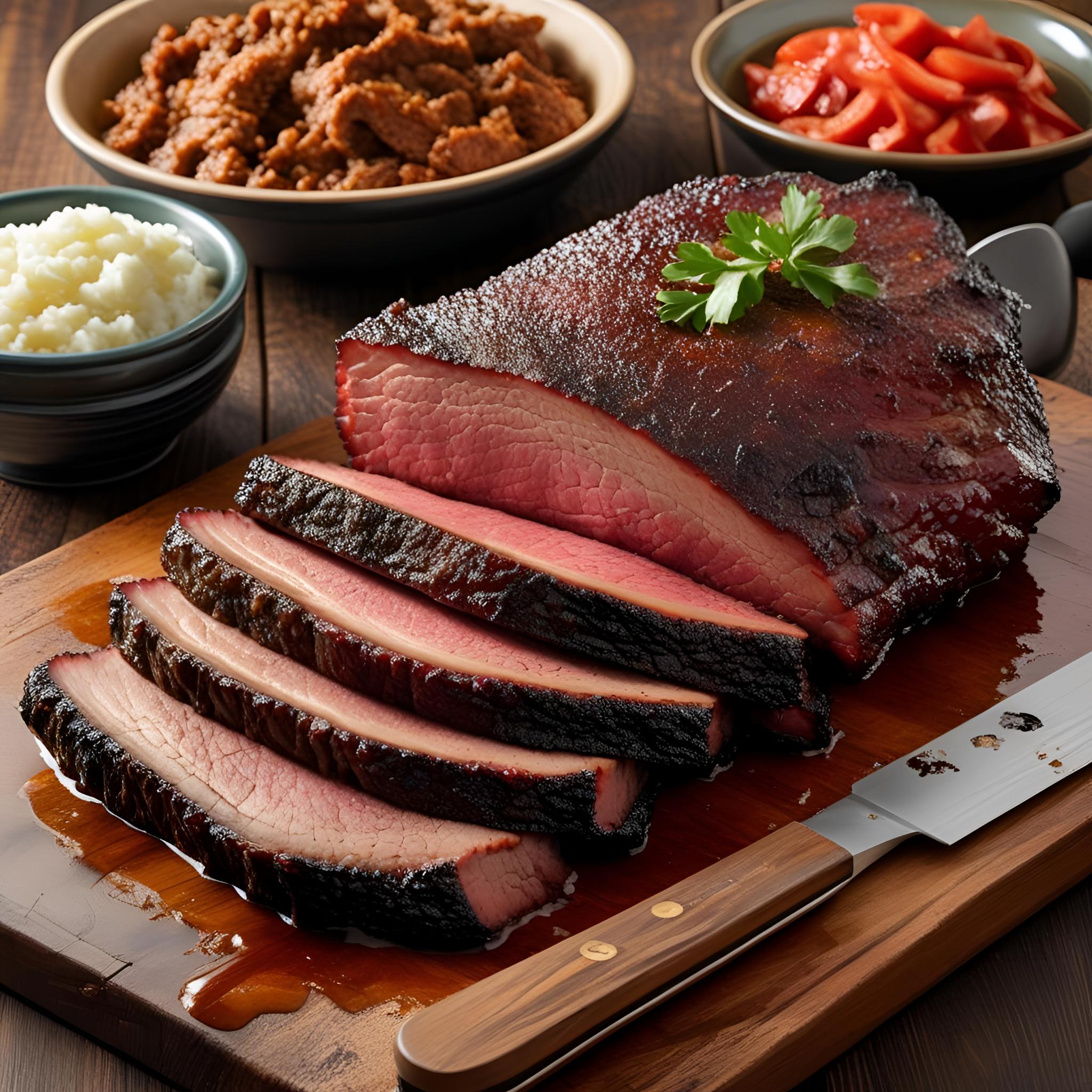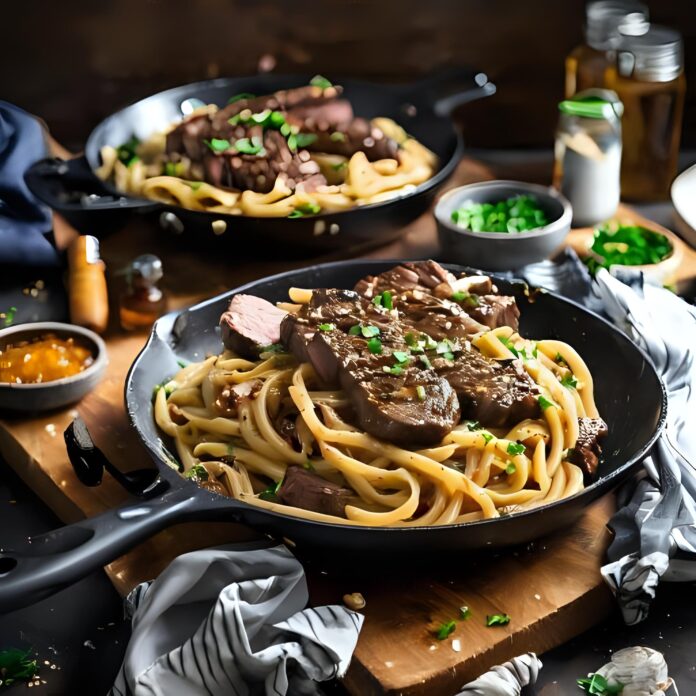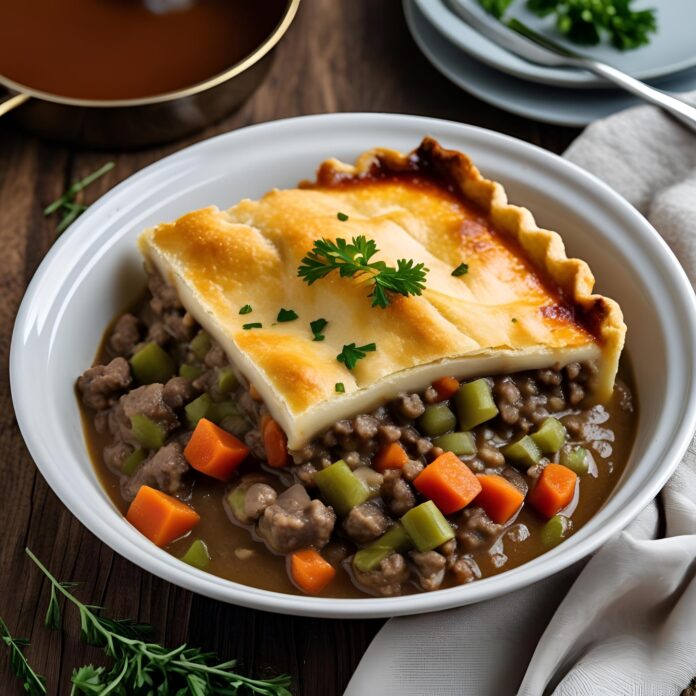Texas-Style Smoked Brisket Recipe
In the vast and diverse culinary landscape of the United States, few dishes evoke as much pride, tradition, and reverence as Texas-style smoked brisket. Deep in the heart of Texas, barbecue isn’t just a method of cooking—it’s a culture, a ritual, and in many communities, almost a religion. And at the very center of this smoky, slow-cooked universe stands one iconic cut of beef: the brisket.

Texas is a state of bold flavors and bigger-than-life food traditions, and brisket reflects all of it. While barbecue around the country may focus on pork, chicken, or regional sauces, Texas barbecue holds brisket as its undisputed king—unadorned by sugary glazes or vinegar-based marinades, and elevated instead by the simplest of seasonings, patient cooking, and the elemental flavor of wood smoke.
The brisket itself is a primal cut, tough and unforgiving in inexperienced hands. It comes from the chest of the cow, a muscle that supports over 60% of the animal’s body weight. As such, it is full of connective tissue, requiring long, slow cooking to become tender and juicy. It’s a cut that demands respect and technique, and when done right, it yields a slice of meat so tender it nearly melts in your mouth, with a bark so flavorful it can stand on its own without sauce.
Texas-style smoked brisket is traditionally seasoned with only salt and pepper—what pitmasters call “Dalmatian rub.” But don’t let the simplicity fool you. The magic lies in the transformation that happens over the course of 12 to 18 hours in the smoker. The long exposure to low heat and aromatic wood smoke creates a dark, crusty bark on the outside, a pink smoke ring beneath the surface, and a tender interior that tells a story with every bite.
This dish has become a defining element of Texas cuisine, especially in the Central Texas barbecue belt—places like Lockhart, Austin, and Taylor—where legendary joints have been serving brisket for generations. But its influence has spread far beyond the Lone Star State, becoming a national and even global phenomenon. Today, aspiring pitmasters from California to Tokyo fire up their smokers in pursuit of the perfect Texas brisket.
In this comprehensive recipe and guide, we’ll explore every step of the brisket journey. From understanding the anatomy of the cut and choosing the right piece of meat, to trimming, seasoning, smoking, wrapping, resting, and slicing—we’ll cover the time-honored techniques used by seasoned pitmasters, as well as helpful tips for backyard barbecue enthusiasts. You’ll also gain insights into wood selection, temperature control, and the ever-important resting period that makes all the difference in texture and flavor.
Whether you’re a seasoned grill master looking to refine your brisket game, or a first-timer curious about what makes Texas-style smoked brisket so legendary, this guide is designed to give you everything you need to master one of the most iconic dishes in American barbecue.
So, take a deep breath, clear your weekend calendar, and get ready to light your fire. Great brisket doesn’t happen quickly. But like all good things, it’s worth the wait.
Step 1: Choosing the Right Brisket
Success starts before the smoker is even lit. Choosing the right brisket is one of the most important decisions in this process.
Understanding the Cut
Brisket comes from the lower chest of the cow and includes two main muscles:
-
The Flat (also called the “First Cut”): This is the leaner, more uniform section. It’s often preferred for slicing and presentation, but it’s also more prone to drying out if not cooked carefully.
-
The Point (also called the “Second Cut” or “Deckle”): This part is thicker, fattier, and more flavorful. It’s often used for burnt ends or chopped brisket.
A full packer brisket includes both the flat and the point, unseparated. This is what most traditional Texas-style brisket recipes call for and is what you want to use for a proper smoke. These typically weigh between 10 and 18 pounds.
Grades of Beef
The grade of beef will significantly affect your end result. In the U.S., you’ll typically find:
-
Select: Leaner and less marbled. Not ideal for smoking.
-
Choice: A decent option with moderate marbling.
-
Prime: The top choice. High marbling, juiciness, and tenderness—ideal for brisket.
-
Wagyu or American Wagyu: Expensive but incredibly tender and juicy. Often used in competitive barbecue.
When possible, choose a Prime-grade full packer brisket from a reputable butcher or meat market.
What to Look For
-
Weight: For your first brisket, aim for a 12-14 lb full packer. This size is more manageable and still gives you a proper balance between the flat and the point.
-
Flexibility: Pick up the brisket and see how it bends. A more flexible brisket often means more marbling and tenderness.
-
Fat Cap: Look for an even fat cap (the thick layer of fat on one side). Around ¼ inch thick is ideal once trimmed.
-
Marbling: Intramuscular fat (the white lines running through the meat) will help keep the brisket juicy during the long cook.
Step 2: Trimming the Brisket
Trimming is essential not just for aesthetics but for even cooking and proper bark formation.
Tools You’ll Need
-
A sharp boning or fillet knife
-
Disposable gloves (optional, but recommended)
-
Cutting board large enough to hold the brisket
-
A trash bowl for scraps
How to Trim
-
Remove Excess Fat from the Point Side:
-
Start by identifying the point (thicker) and flat (thinner) ends.
-
On the point side, trim off any large, hard chunks of fat. These won’t render during the cook.
-
-
Trim the Fat Cap:
-
Flip the brisket so the fat cap is facing up.
-
Carefully shave the fat down to an even ¼-inch thickness across the surface.
-
Be cautious not to remove all the fat—this layer helps protect the meat during smoking and contributes to flavor.
-
-
Square the Edges:
-
Clean up ragged or thin edges. These can burn or dry out during cooking.
-
Some pitmasters square the brisket slightly to improve appearance and ensure uniform cooking.
-
-
Remove the Silver Skin:
-
On the meat side, carefully remove any silver skin (a tough, shiny membrane) using the tip of your knife.
-
-
Optional: Make an Aerodynamic Shape:
-
Some pitmasters round off corners or shape the brisket to promote even airflow in the smoker and consistent cooking.
-
Tip
Save the fat trimmings—you can render them later for tallow, which some use during the wrap or to baste slices later.
Step 3: Seasoning the Brisket
Texas-style brisket is all about simplicity. The traditional rub consists of just kosher salt and coarse black pepper.
The Dalmatian Rub (Classic Central Texas Rub)
-
1 part coarse kosher salt
-
1 part 16-mesh black pepper
That’s it. No sugar, no garlic, no paprika—just pure beef flavor with a smoky bark.
You can adjust to personal taste, but if you’re aiming for authenticity, start here.
Optional Additions (if you want to experiment):
-
A touch of garlic powder (¼ part)
-
A dash of paprika (for color)
-
Crushed red pepper flakes (for heat)
Applying the Rub
-
Pat the brisket dry with paper towels.
-
Lightly oil the surface (optional, to help the rub stick—use mustard or neutral oil).
-
Apply the rub liberally, coating all sides of the meat, including the edges. Don’t rub it in—just pat it on gently.
-
Let it rest at room temperature for 30-60 minutes while you prepare your smoker. This allows the rub to adhere and slightly penetrate the surface.
Step 4: Preparing the Smoker
The heart of Texas-style brisket lies in the low-and-slow smoke. You’ll need steady heat and clean, flavorful smoke.
Smoker Types
-
Offset Smoker (Traditional Stick Burner): Best for authentic results. Uses real wood logs for heat and smoke.
-
Pellet Smoker: Easier temperature control, still yields great results with wood pellets.
-
Kamado or Ceramic Grill: Excellent heat retention, can be dialed in for low-and-slow cooking.
-
Electric or Propane Smoker: Convenient, but often lacks the depth of flavor from a wood fire.
Wood Selection
Texas brisket is traditionally smoked with:
-
Post Oak: Mild, sweet, and smoky. The standard in Central Texas barbecue.
-
Hickory: Stronger smoke flavor—use sparingly.
-
Pecan: Sweet and nutty.
-
Mesquite: Very bold—best used in moderation or blended.
Avoid softwoods like pine or cedar—they produce unpleasant smoke.
Fire Management
-
Target Temperature: 225°F to 250°F (107°C to 121°C)
-
Preheat Time: Give your smoker at least 30–45 minutes to stabilize.
-
Clean Smoke: You want thin blue smoke, not thick white or gray plumes. This indicates clean combustion.
Use a reliable thermometer to monitor both smoker temperature and internal meat temperature.
Texas-Style Smoked Brisket Recipe
In the vast and diverse culinary landscape of the United States, few dishes evoke as much pride, tradition, and reverence as Texas-style smoked brisket. Deep in the heart of Texas, barbecue isn’t just a method of cooking—it’s a culture, a ritual, and in many communities, almost a religion. And at the very center of this smoky, slow-cooked universe stands one iconic cut of beef: the brisket.
Ingredients
- 1 whole packer brisket (10–14 lbs), untrimmed
- 1/4 cup kosher salt
- 1/4 cup coarse ground black pepper
- Optional: 1 tbsp garlic powder (for Texas purists, stick to salt & pepper only)
- Recommended Wood:
- Post oak (traditional)
- Hickory or mesquite are acceptable alternatives
Instructions
1. Trim the Brisket
- Leave about 1/4" fat cap on top
- Trim off any large hard fat and silverskin
- Square edges for even cooking
2. Season
- Mix kosher salt and black pepper in a 1:1 ratio
- Optionally add garlic powder
- Season all sides generously and evenly
3. Dry Brine (Optional but Recommended)
- Wrap in butcher paper or place on a rack in the fridge uncovered
- Refrigerate for 12–24 hours to let salt penetrate the meat
4. Preheat the Smoker
- Preheat to 225–250°F (107–121°C)
- Use post oak wood for classic flavor
5. Smoke the Brisket
- Place brisket fat-side up (or down depending on your smoker’s heat source) in the smoker
- Insert a meat thermometer probe into the thickest part of the flat
- Smoke until the internal temperature hits 165–170°F (74–77°C), about 6–8 hours
6. Wrap
- Wrap brisket in butcher paper (preferred) or foil
- Return to smoker
7. Continue Smoking
- Smoke until the internal temp reaches 200–205°F (93–96°C)
- Probe for tenderness: a meat probe should slide in like butter
8. Rest
- Let the brisket rest, wrapped, in a cooler or oven (off) for at least 1 hour, up to 4 hours
- Resting allows juices to redistribute
9. Slice and Serve
- Slice against the grain
- Separate the point and flat muscles to follow the grain properly
- Serve with pickles, onions, and white bread—or enjoy solo
Notes
- Salt & pepper only is traditional for Texas BBQ. Resist the urge to over-season.
- Wrap timing varies. Some pitmasters wait until 170°F; others go by bark development.
- Spritzing (with water, apple cider vinegar, or beef broth) every hour before wrapping can help keep the bark moist.
- For better bark, avoid wrapping too early or using foil, which steams the crust.
- Great brisket takes time and patience. Don’t rush it!



